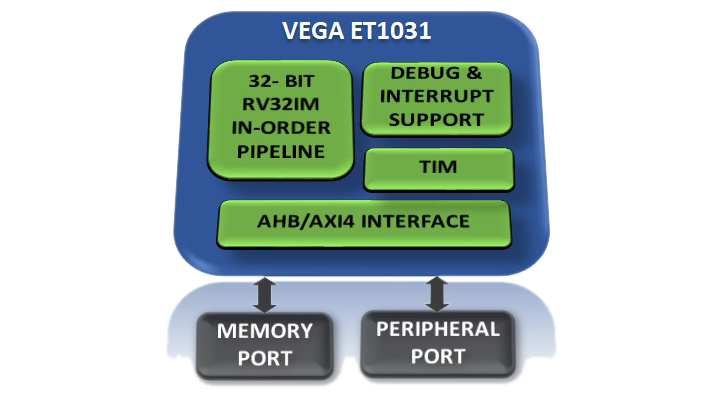India continues to innovate homegrown RISC-V, launches Aries 3.0 board with an onboard Vega ET1031 CPU
RISC-V, as an open platform, gives countries like India a chance to break into semiconductors.

India's home-built RISC-V CPUs have launched to developers in the form of the Aries v3.0 development board, which boasts the Vega ET1031 RISC-V CPU. Before we dive deep into the numbers, we should go ahead and clarify that the Aries v3.0 board is aimed at sensors, IoT devices, wearables, and other simple tech— not a full-blown PC by any means.
Now, let's talk about those specs. According to a recent report from The Register, the CPU is 32-bit and operates at up to 100 MHz, using only 256 KB of SRAM. This doesn't come close to competing with modern Raspberry Pi solutions, but it will probably be more than enough for the intended applications in IoT, toys, and so on. Some devices only need the most basic of processing.
As a fun thought exercise, though, let's compare these CPU and RAM specs to 90s video game consoles. Now, the CPU architectures aren't going to be directly comparable for many reasons, but the raw numbers make for an interesting comparison.
The Super Nintendo, launched in 1990, came with 128 KB of RAM and a 3.58 MHz 16-bit CPU. The Nintendo 64 launched in 1996 and came with a solid 4 MB of RAM and a clean 93.75 MHz, 64-bit CPU.
In terms of overall processing power, the Vega ET1031 might be stronger than the N64. It's certainly leaps and bounds beyond the humble SNES, which couldn't even push 4 MHz, much less 100.
But since these Vega ET1031 devices aren't tailored for gaming or even basic PC use, the memory requirements are quite low. That 256 KB of RAM is twice the amount available in the SNES (only capable of 2D graphics), but a mere sixteenth of what's needed to drive an N64, and that's not counting the Expansion Pak.
For a full list of key features and intended applications for the Vega ET1031, check out its official page— though you won't find much more info than what we've given here. Fortunately, none of the expected applications involve 3D graphics or more than the most basic display functionality, so the Vega ET1031 should still work well in those niches.
Get Tom's Hardware's best news and in-depth reviews, straight to your inbox.
Overall, Aries v3.0 seems to be a positive step forward for India's initiative to push into semiconductors. Way back in 2019, we covered India's first RISC-V Shakti processors, which are still being iterated upon today as higher-end alternatives to their Vega chips. In the time since 2019, RISC-V has only grown as an open alternative, with a forecast of more than 16 billion license-fee-free RISC-V chips on the market by 2030.

Christopher Harper has been a successful freelance tech writer specializing in PC hardware and gaming since 2015, and ghostwrote for various B2B clients in High School before that. Outside of work, Christopher is best known to friends and rivals as an active competitive player in various eSports (particularly fighting games and arena shooters) and a purveyor of music ranging from Jimi Hendrix to Killer Mike to the Sonic Adventure 2 soundtrack.
-
brandonjclark This is good, and I hope India continues to innovate and forge ahead.Reply
However, for their size, I've not seen much progress internally. And it's not just in CPU-tech.
Another example would be software coding.
Is India full of amazing coding talent? Well duh, of course it is! So then where are the major homegrown industries like 3d gaming or financial technology?
Maybe this is just my ignorance showing and there ARE really great, globally-known homegrown Indian software or technology companies which are NOT offshoots of US or Euro or China, and I welcome being schooled! -
bit_user ReplyThe CPU is 32-bit and operates at up to 100 MHz, using only 256 KB of SRAM. This doesn't come close to competing with modern Raspberry Pi solutions
It's effectively a microcontroller, not a proper CPU. The Raspberry Pi it should be compared with is the Pico.
Dual-core Arm Cortex-M0+ processor, flexible clock running up to 133 MHz
264kB on-chip SRAM
The Nintendo 64 launched in 1996 and came with a solid 4 MB of RAM and a clean 93.75 MHz, 64-bit CPU. In terms of overall processing power, the Vega ET1031 might be stronger than the N64.
This is nuts. No, this thing can't touch it! And not just because of the 32-bit vs. 64-bit thing, but also that the N64 had the RCP, which was a sort of GPU, featuring 128-bit SIMD.
And then there's the issue of floating point. According to this, the core only supports integer arithmetic, whereas the N64's VR4300 supported floating-point arithmetic!
Sources:
https://github.com/ultraembedded/riscv https://en.wikipedia.org/wiki/Nintendo_64
Wow. Even if the author didn't know this stuff, you'd think one of the editors would clue him in.